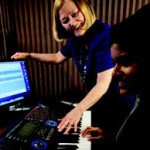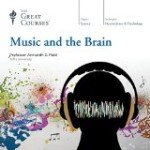
2015 DVD course – Music & the Mind
Dear Reader,
I am currently running a research project over in the United States. Earlier this year I was granted a Worldwide Universities Network (WUN) Researcher Mobility grant, allowing me to work in the US. My grant is called ‘Memory ability and the musical mind’.
 As part of my WUN research programme I am conducting a joint project with Professor Elizabeth West Marvin (pictured), who is based in the Eastman School of Music at the University of Rochester.
As part of my WUN research programme I am conducting a joint project with Professor Elizabeth West Marvin (pictured), who is based in the Eastman School of Music at the University of Rochester.
Professor Marvin is an expert in the psychology of absolute (perfect) pitch (AP), the ability to name notes in the the absence of an external reference. She and I are keen to better understand the memory abilities of people with AP, as well as their varying phenomenological experiences. We are also exploring perceptions of AP ability in training musicians who do not have this skill.
I am living in Rochester and working with Professor Marvin until December. I am looking forward to my first experience of a US Halloween, Thanksgiving, and the build up to Holiday season.
As well as conducting my WUN research project, I have time to attend and give talks at Rochester. In my first week I enjoyed a presentation on research into music listening experiences given by Professor Elizabeth Hellmuth Margulis. I am also looking forward to giving talks about my research, papers on amusia, memory and wellbeing, to lab groups and colleagues in nearby areas.
One of these colleagues is Professor Ani Patel, who has invited me to give a talk on musical memory at Tufts in December. In our chats to arrange this visit, Professor Patel informed me that he had recently completed a new DVD course on music cognition. He offered me a chance to watch this new course to see what I think. I jumped at the chance! Here is my summary of that course for you, Dear Reader, with no bias on my part. I speak as I find, as I am sure many of you know 🙂
 Music and the Brain (The Great Courses) is a 18 part DVD music cognition course that explores the origins of music’s power; the links between hearing, moving, and imagining. Each lecture is about 30 minutes long.
Music and the Brain (The Great Courses) is a 18 part DVD music cognition course that explores the origins of music’s power; the links between hearing, moving, and imagining. Each lecture is about 30 minutes long.
The course has a clear structure from early lectures on the origins and evolution of music (one of Professor Patel’s areas of expertise, having a Ph.D in Organismic and Evolutionary Biology from Harvard) through to later lectures on the building blocks of music; pitch, timbre, and rhythm.
The latter lectures cover the cognitive benefits of musical training, disorders of music cognition, and the brain effects of both hearing and making music. He also touches on new studies of music therapy and the question of whether we are the only musical species on the planet.
I was excited to see this course. In my opinion it meets a real need in our discipline. In the UK our postgraduate students often have little knowledge of music psychology before committing at least a year of their life and finances to a related Masters or PhD course. This is no fault of theirs. There are few undergraduate modules in music psychology, and no full courses. I have lost track of the number of times I have been asked by readers of this blog if there are any courses I would recommend to students while they are trying to make this life decision.
There are excellent books that give you a flavour of music psychology (my own included!), but this is the first DVD course to engage with many of the core areas in our discipline. Of course it does not cover all areas of study you see in a graduate course. The focus is on neuroscience (the clue is in the title, Music & The Brain!) and comparative studies with, by comparison, only passing references to studies from musicology, social or educational issues. But importantly the course covers what I would consider the ‘basics’ of understanding musical sound and its effects on us. And the presentation is excellent. The lectures are structured around questions that make narrative and logical sense.
Professor Patel’s spoken style is engaging and professional. He was always one of my favourite speakers as a student, something I share with others if the typical sizes of his conference audiences are to be taken as any indication. His expositions are a pleasant mix of relateable anecdotes, musical and visual examples, experiments, ideas, and thought provoking open ended questions with a nod to the possible future of music psychology.

I would recommend this DVD to potential music cognition/ psychology students. There is also a much wider audience out there who would enjoy the lectures. Present graduate students, PhDs and postdocs would benefit from the course, even if the studies covered are in their area and they can claim to know most of the information. This presentation is more than just facts; it is a window into the challenges and intrigues of music psychology, as laid out by an expert. I have really enjoyed listening to the lectures and have found them to be a valuable refresher of my own knowledge.
The course has also given me ideas about teaching the topics covered. I have been inspired by the mix of interesting images, videos and sounds that both pepper the lectures and add colour to the ideas therein.
Academics can be funny about admitting they don’t know things in their own discipline. But I am admitting – for you Dear Reader – that this course taught me many things.
In the spirit of sharing here are just a few of the things I learned:
- One argument for the evolution of music is ‘gene- culture coevolution’ also known as Dual Inheritance Theory. This idea states that music was a human invention rather than something we were always designed to do, but that it was such a powerful cultural shift that it changed the course of our genetic development. Instead of adopting one or the other argument (nature vs. nurture) you have environment influencing genes and so on in a continuous loop. I like it.
- Charles Darwin once took mints, verbena and a harmonica into the room with a famous Orangutan called ‘Jenny’ to see if she enjoyed similar aesthetic things as humans. She liked all the objects and even picked up the harmonica after seeing it played, appearing to try to make the sounds herself.
- Children who have engaged in synchromising musical games are more likely to show co-operation and prosocial behaviours in subsequent tasks compared to when they play similarly fun but non-musical games. This finding adds even more evidence to the idea that music in schools is important as children grow up; more than just learning an instrument or voice. You can find that paper here.
The course achieves a nice balance of, in Professor Patel’s words, taking the subject ‘out of the armchair and into the lab’. As well as walking the listener through facts (such as how we perceive pitch or how different areas of the brain process music), Patel talks through multiple experiments that have lead to this knowledge, both modern and classic examples, in a clear and guided manner taking the time to explain the different conditions, results and general implications.
Patel also raises questions for the listener (these are mirrored in the accompanying text guide), an effective teaching strategy that encourages the viewer to see both the accomplishments and limitations of research to date, and to think about where we might go next as well as the practical implications of music psychology research.
I like that there are two main themes to the course. Introduced in Lecture 4, they re-appear throughout the subsequent sessions, reminding the viewer of their importance across multiple areas of music psychology interest:
 1. Multiple simultaneous mechanisms. Our responses to music are the result of almost instantaneous activations across numerous brain systems, both ancient (limbic system) and more modern (cerebral cortex). Our subsequent reactions represent a sum total of these activations.
1. Multiple simultaneous mechanisms. Our responses to music are the result of almost instantaneous activations across numerous brain systems, both ancient (limbic system) and more modern (cerebral cortex). Our subsequent reactions represent a sum total of these activations.
Forget the idea that there is one brain area for music or even for different aspects of musical engagement. Think instead of a web of activations spreading in an instant across your brain: high and low; shallow and deep. Our responses have been honed over tens of thousands of years of evolution, the most complex interactive highway system you could imagine.
Knoweldge of these activations and their patterns is set to grow as brain imaging technologies are refined in temporal and spatial resolution.

2. Shared processing between music and language. This debate highlights how there is little to be gained by sticking to either strict shared or isolation processing arguments.
It was always the case that there was going to be some sharing of processing between music and language; after all, they are both universal sounds that humans make that can carry a message.
Interesting findings come about when people aim to determine exactly where/ why/ how sharing of brain and cognitive mechanisms occur. These results tell us about the role of music in our lives, how it came about, and speak to the role of brain and thought processing more generally.
I asked Professor Patel to comment on the challenges he faced when designing the course and what he thought of the outcome. He told me:
 “In making this course I tried my best to talk to non-scientists in ways which they could engage with, but without diluting the science.
“In making this course I tried my best to talk to non-scientists in ways which they could engage with, but without diluting the science.
One thing that surprised me as I prepared the course is how much I relied on recent (sometimes VERY recent) discoveries in our field.
Unlike courses on physics, math, or general psychology, much of what we know about music cognition was discovered in the past few decades, and this made the course exciting to put together.”
The excitement and spark that Professor Patel clearly feels in response to the rapid and increasingly diverse progress in our discipline is infectious – it hooked me as a young graduate student and it still grips me as a not-so-young lecturer and researcher.
I have no doubt that this course will inspire many people to delve deeper into the fascinating world of music psychology; perhaps for study, perhaps for further reading, or perhaps simply as a trigger for thoughts in peaceful moments of contemplation. Whatever your aim, you will enjoy the experience.
The people at Great Courses are offering a discount on Professor Patel’s course until December 31st 2015. If you are interested then follow the relevant link for you:
I am based in the UK and am interested in the Music and the Brain course
I am based outside the UK and am interested in the Music and the Brain course


One Comment
Diana Hereld
Ah dear Vicky! I had no idea you were staying in Rochester and working on this. That’s brilliant! I hope you had a lovely first American Halloween, and the same for Thanksgiving. I wish I was going back that way – I’m afraid the most East I will go is for my paper at SEM in Austin. Hope all is very well!
ps. Thanks for the reminder – preparing for a lecture and I’d completely forgotten about Ani’s videos – definitely a great resource. Can’t wait to see where your many directions of research go next.